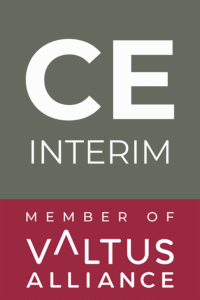¿No tiene tiempo para leer el artículo completo? Escuche el resumen en 2 minutos.
La economía europea, diversa e interconectada, se enfrenta a menudo a los efectos imprevisibles de las recesiones. Mientras algunos sectores se contraen de forma significativa, otros pueden aprovechar oportunidades únicas de crecimiento a través de una eficaz estrategia empresarial en recesión.
A estrategia a prueba de recesiones es esencial para navegar con eficacia en tiempos turbulentos, especialmente en Europa, donde las normativas transfronterizas, las complejidades de la cadena de suministro y las fluctuaciones monetarias añaden capas de complejidad.
En este artículo exploraremos estrategia empresarial en recesión adaptada específicamente al mercado europeo, centrada en enfoques prácticos para planificación financiera, gestión de la cadena de suministroy optimización de la mano de obra.
También destacaremos cómo los servicios estratégicos de gestión interina pueden ayudar a su empresa a sobrevivir y prosperar.
1. La complejidad de las cadenas de suministro europeas y cómo navegar por ellas
Durante una recesión, una de las primeras áreas críticas con las que suelen luchar las empresas es su cadena de suministro. Para las empresas europeas, las interrupciones de la cadena de suministro pueden ser especialmente graves, dada la gran dependencia del continente del comercio transfronterizo. Incluso las interrupciones menores, agravadas por la fluctuación de los tipos de cambio y la normativa comercial, pueden provocar cuellos de botella que pongan en peligro operaciones enteras.
Tomemos como ejemplo la industria del automóvil. Volkswagenuno de los mayores fabricantes de automóviles de Europa, se ha enfrentado históricamente a serios retos cuando se deterioran las condiciones económicas mundiales. En respuesta, aplicaron estrategias como deslocalización cercana-trasladar algunas de las operaciones de su cadena de suministro más cerca de sus principales mercados europeos. Al reducir su dependencia de las importaciones de larga distancia, aumentaron su flexibilidad y eficacia en tiempos de crisis.
Soluciones estratégicas para la resistencia de la cadena de suministro
- Deslocalización y localización: Para mitigar los riesgos, las empresas deben considerar deslocalización cercana sus operaciones de producción y abastecimiento. Esto reduce la exposición a riesgos internacionales y garantiza tiempos de respuesta más rápidos.
- Gestión digital de la cadena de suministro: Invertir en herramientas digitales para supervisar y prever las necesidades de la cadena de suministro puede minimizar las interrupciones. La IA y el aprendizaje automático pueden analizar las tendencias de compra, lo que permite a las empresas abastecerse de suministros esenciales antes de que se agrave la crisis.
Además, si su empresa se enfrenta a un problema crítico de la cadena de suministro o a una complejidad operativa, trabajar con un equipo ejecutivo interino puede marcar la diferencia. La red de gestores interculturales de CE Interim puede evaluar rápidamente los riesgos de la cadena de suministro, agilizar las operaciones e impulsar transformaciones para la continuidad del negocio.
2. Cobertura financiera: Protección frente a las fluctuaciones monetarias
Las empresas europeas operan a menudo en varias divisas y, durante una recesión, la inestabilidad de la economía mundial puede causar importantes pérdidas. fluctuaciones monetarias. Una caída del valor del euro frente al dólar o la libra puede afectar gravemente a los márgenes de beneficio de las empresas con operaciones transfronterizas.
Para ello, las empresas deben adoptar estrategias de cobertura para protegerse de los riesgos cambiarios. Esto fue especialmente evidente en empresas como Airbusque se cubría activamente contra las fluctuaciones monetarias para protegerse de pérdidas significativas en tiempos de incertidumbre económica. Para mitigar los riesgos derivados de la volatilidad de los mercados de divisas, bloquean los tipos de cambio y negocian las operaciones en euros siempre que es posible.
Estrategias financieras clave para mitigar el riesgo
- Contratos a plazo: Fijar ahora un tipo de cambio para futuras transacciones ayuda a proteger sus márgenes de las oscilaciones del mercado. Esto es especialmente importante en sectores como el manufacturero o el tecnológico, que dependen en gran medida de las importaciones y exportaciones.
- Diversificación de divisas: Las empresas que realizan regularmente operaciones transfronterizas deberían considerar la posibilidad de mantener cuentas en varias divisas para reducir las pérdidas por conversión.
Las empresas que encuentran abrumadoras estas complejidades financieras pueden beneficiarse de dirección financiera provisional. En periodos de recesión, los Directores Financieros (CFO) de empresas como CE Interino puede desplegarse rápidamente para dirigir reestructuraciones críticas, garantizar la gestión de la tesorería y supervisar complejas estrategias de cobertura para estabilizar el negocio.
3. Optimización de la plantilla: Más que una reducción de plantilla
Durante las recesiones, el instinto de muchas empresas es reducir los costes de mano de obra mediante despidos. Sin embargo, en Europa, donde la legislación laboral es estricta -sobre todo en países como Alemania y Francia-, las empresas deben pensar de forma más estratégica. Un recorte repentino de plantilla no sólo puede acarrear cuantiosas sanciones, sino también perjudicar el rendimiento a largo plazo al vaciar a la organización de competencias esenciales.
En lugar de reducir plantilla, empresas como Siemens adoptaron estrategias más creativas de gestión de la mano de obra durante las recesiones económicas. Pusieron en práctica programas de trabajo de corta duración (Kurzarbeit en Alemania), lo que les permitió reducir las horas de trabajo en lugar de suprimir empleos. De este modo, mantuvieron intacto su talento y se beneficiaron de las subvenciones públicas.
Estrategias innovadoras de mano de obra para tiempos de recesión
- Programas de trabajo de corta duración: Muchos países de la UE ofrecen planes que permiten a las empresas reducir las horas de trabajo de sus empleados y mantenerlos en nómina con ayudas públicas. Así no solo se mantiene la moral, sino que no se pierden valiosos talentos.
- Recualificación y mejora de las cualificaciones: Otro enfoque consiste en invertir en formación su plantilla actual para adaptarse a las cambiantes demandas empresariales. Dado que la transformación digital se acelera durante las recesiones, volver a capacitar a los empleados para manejar las nuevas tecnologías puede preparar a su empresa para una recuperación más sólida.
4. La innovación como estrategia de crecimiento durante las recesiones
Aunque reducir costes es esencial durante una recesión, muchas empresas de éxito aprovechan las recesiones como una oportunidad para innovar. Las empresas que aceptan el cambio y se adaptan a las nuevas realidades del mercado suelen salir reforzadas cuando la economía se recupera.
Por ejemplo, Zalandouna de las principales plataformas europeas de comercio electrónico, incrementó su transformación digital durante la última crisis económica. Al integrar soluciones de marketing basadas en IA y ampliar la logística, la empresa se posicionó para un crecimiento significativo cuando el mercado se recuperara.
Ámbitos de innovación y transformación
- Automatización e IA: La integración de la automatización en los flujos de trabajo operativos puede agilizar los procesos y reducir los costes. Desde la logística al servicio de atención al cliente, las herramientas de IA ayudan a las empresas a mantener la eficiencia sin aumentar la plantilla.
- Innovación impulsada por la sostenibilidad: Con Europa presionando para modelos empresariales sosteniblesAlinear los objetivos de su empresa con el Green Deal europeo no sólo reduce costes gracias a la eficiencia energética, sino que también le permite beneficiarse de incentivos ecológicos.
Conclusiones: Estrategia empresarial para la recesión
Navegar por una recesión europea requiere una combinación única de perspicacia financiera, adaptabilidad operativay pensamiento innovador. Las empresas que adoptan estas estrategias, desde resistencia de la cadena de suministro a cobertura financiera y optimización de la mano de obrano sólo sobrevivirán, sino que prosperarán en un clima económico incierto.
En momentos de crisis, muchas empresas se dan cuenta de que necesitan un liderazgo especializado que las guíe a través de la reestructuración, los retos operativos o las oportunidades de crecimiento. CE Interino ofrece soluciones interculturales de gestión interinaEn la actualidad, la gestión de las funciones críticas de su empresa está en manos de líderes experimentados que pueden intervenir para garantizar que su empresa salga de la recesión más fuerte que antes.
Ahora es el momento de replantearse su estrategia de recesión y dotar a su empresa de las herramientas y el liderazgo que necesita para triunfar, independientemente de lo turbulento que se vuelva el panorama económico.





